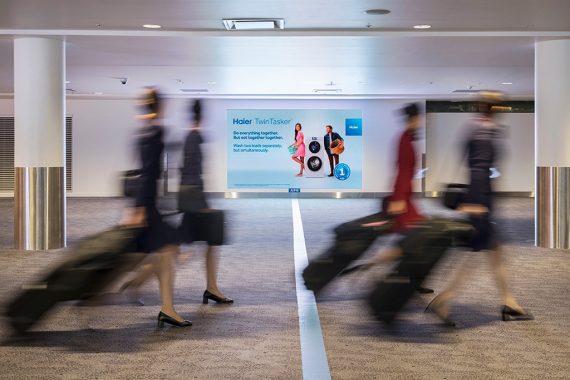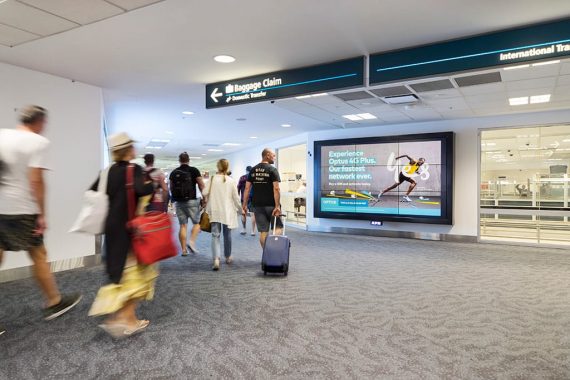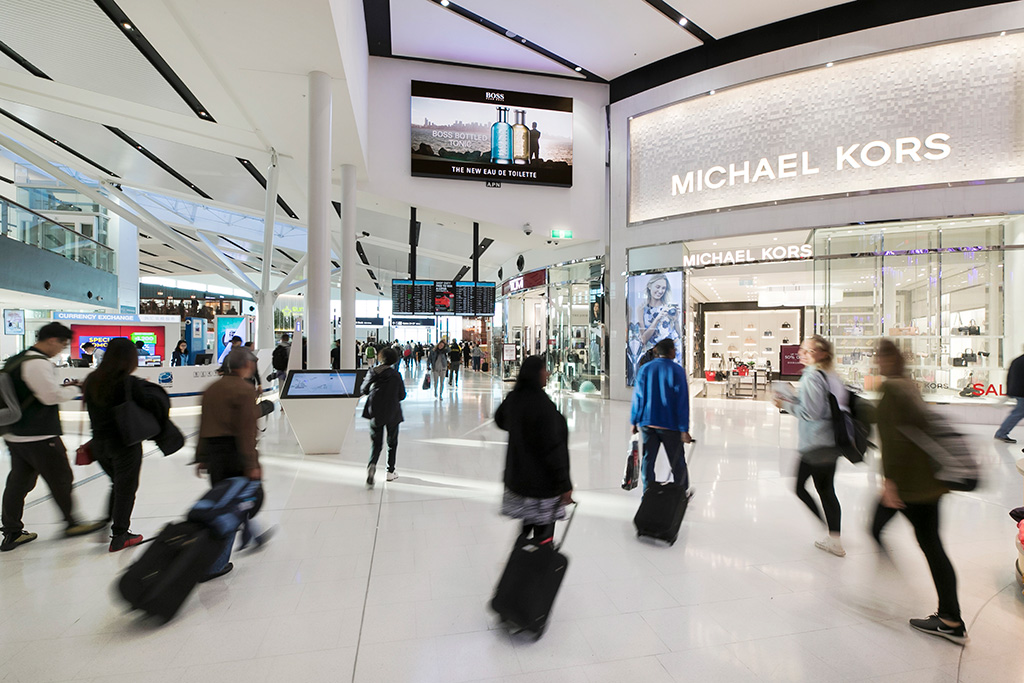
Martin Salter reflects on his time driving digital innovation in Sydney Airport and what the future of digital signage will look like.
Story: Martin Salter
Forget about digital strategy. In a world where everything is digital then you need to be looking at your customer strategy rather than a digital strategy.
You’ve heard the catchphrase ‘content is king’ (admittedly from five or 10 years ago)? Now, just the customer is king.
Admittedly, the customer has always been king but the industry is only now catching up — your strategy should entail the best ways to engage the customer.
Traditionally the signage strategy has been about putting a sign where you see the most traffic. You’ll target a vast amount of people with a mass-reach philosophy — one message to all, no matter the wastage.
That’s an out-of-date strategy. The technology has caught up and allows us to be more targeted and strategic than that. There’s no longer any need to be so scattergun.
Now the technology exists for us to use what’s called predominant profiling. You don’t have to target someone specifically but you can target a group in a predominant way, which makes for a more efficient delivery of your message, without the mass reach wastage.
FLYING HIGH
Sydney Airport was a great testbed for signage — it’s a unique environment where you have a vast number of people in dwell for a good period of time.
The people you’re talking to are excited — the majority of travellers are on holiday and because of that holiday mindset they’re more inclined to be open to messages.
AIRPORT STRATEGY
Sydney Airport is a business where you’re encouraged to try new things — if it wasn’t for that support it wouldn’t have happened.
Our original strategy was based on understanding the passenger. If I’m flying to London do I want to see Sydney’s weather? No, I would like to know what’s happening in London: What’s the weather like when I’m there? What’s happening when I’m there? Can I book a hotel? Can I book a restaurant?
From there came the evolution of Norman [Cantrell, MD of TechMedia] and I talking and saying: how can we contextualise or categorise a profile of someone that’s at Gate 32 flying to London? Can we deliver content to that screen, that media player and expose those people to relevant content for the hour they’re dwelling and engaged? If we can, that is going to make their experience far superior to an old-school approach of sending the same content to the masses, with the associated wastage that comes with that approach. It’s better for the customers and better for the airport’s advertising clients.

DISPLAY LOCATION: APN’S PHILOSOPHY
“APN Outdoor’s digital mantra is to position assets by design not default. Our panels are positioned to connect brands with consumers in a way that will resonate. High dwells at strategic points of impact translates to engagement for brands. This combined with the heightened emotion experienced in the Airport environment at points such as Check-in, Duty Free and Gate Lounges all provide the perfect opportunity to influence. We value this approach of purposeful placement and adopt this in the positioning of all our assets at APN Outdoor.”
APN Outdoor: www.apnoutdoor.com.au
CRUCIAL WI-FI
Sydney Airport was the first to install high-density wi-fi back in 2010 and it’s gone from strength to strength.
The screens may be the heart of a digital signage solution but the wi-fi is the brain and the two have a symbiotic relationship. Wi-fi allows you to extract valuable analytics and then use that data to improve the customer experience.
Predictive analytics need to play a huge part in the future of signage. Wi-fi can help to segment your audience, not just by gate (if you’re an airport) but by a specific zone, which is something we achieved last year at Sydney Airport.
Predictive analytics will also assist asset owners, helping them to apportion resources, helping to create operational efficiency and enhancing customer experience. You might need five checkouts open rather than four thanks to what you know from wi-fi.
Wi-fi is breaking the shackles of needing apps and beacons. If you have an access point, a smartphone and a screen, you’ve potentially got something that can work together.
When you’re logging on to wi-fi you are sharing your information with the providers, and privacy guidelines need to be adhered to. I believe people need to be afforded the courtesy of opting in to a mailing list. And once you have that permission you use that information for the benefit of the customer; use that information to understand your customer better, which will, in turn, inform your choices as an organisation.
WHERE TO PUT SCREENS?
Sydney Airport was a really interesting project to work on. And determining where to locate screens with APN required a lot of thought and research — eight months, in fact.
It was an investment and we needed to be sure the signage, once installed, would look like it belonged there.
I was pleased we put in that legwork. It’s clearly better to invest in that development and design prior to the rollout.
The solution we arrived at was a good one.
WEB & SIGNAGE COMBINE
The digital industry are using cookie data to understand your browsing history. There’s no reason why we can’t aggregate those insights and use them to determine content on our digital signage platforms. Whether it’s a MAC address, an API or wi-fi we can begin to understand what your customer is doing such that you can provide the right message for the right environment, to deliver content based on what they’ve been viewing.
There’s a huge opportunity for data and cookie commercialisation businesses in out of home right now. If they partner with digital signage businesses and media companies to integrate their information and insights, then you have a new level of granularity, where the right content appears on the best screens.

BESPOKE TECH
The digital signage technology needs to be flexible. It needs to be customised based on the needs of the solution. I’ve been working with TechMedia and Scala for years. What’s been great about TechMedia and the product it represents is it’s customisable. You must have a solution that’s tailor made to your needs.
PORTRAIT OR LANDSCAPE?
At Sydney Airport, we went through a period where we had a large number of 3×3 video walls. Back then, they were almost seamless and far more cost effective than fine pixel pitch LED.
We also went through a period where ‘portrait was cool’ and now the landscape format is preferred because of its greater flexibility. and link with in-source and out-sourced digital video. A lot of people want to play TV commercials and will need a regular portrait oriented display.
Fifiteen seconds became the norm for us.
As the technology evolved, in 2012 we were one of the first airports in the world to integrate our flight information display system (FIDS) with our advertising scheduling software Scala and that allowed us to contextualise and to segment our audience.
I believe the next phase in the evolution of signage is ‘predominant profiling’, something we completed at Sydney Airport in 2016 — displaying content pertinent to most of the patrons in that vicinity.
Next step is intent — how do you understand an audience from what they intend to do rather than what they’re actually doing.
This is one of the areas I’m now concentrating on as a consultant. I’m helping organisations to create a link between the signage and the customer; to understand who the customer is at any given time. With that knowledge you can have a greater level of engagement with the customer, an engagement that’s subtle yet powerful.
You can hit up Martin Salter on martin@2hmediasolutions.com.au
THE ENGINEER’S VIEW
Norman Cantrell is Managing Director and founder of TechMedia, the key technology partner in the rollout of the Sydney Airport digital signage. TechMedia has represented the digital signage platform, Scala in Australia since 2000.
Norman Cantrell: Digital Signage is really starting to deliver on its promise: ‘the right message, at the right time and the right place’.
A network today and into the future gives advertisers the chance to drill down and get to their audience at the point of purchase. This is the beauty of a properly deployed signage network.
Scala has been around 30 years and has some formidable features because of that longevity in the industry. Scala as a platform gave us the power and freedom in a project like the Sydney Airport to customise and execute Martin’s vision for the airport.
Scala’s speed was also a factor. Not only did we need to bring a number of technologies together, it needed to respond quickly. It needed to react to the flight info data, and to push content to the right screen at the right time.
It’s a credit to my team for embracing the complexities of the project, but it was also exciting to work on. I travel extensively and I wasn’t seeing other airports anywhere else in the world doing anything similar. Sitting at a gate waiting to fly to New York and seeing something relevant, not generic, was a breakthrough. Being the first made it exciting.
As Martin mentioned, wi-fi has been a game-changer for digital signage. Wi-fi makes us more relevant.
Wi-fi gives landlords the opportunity to know where their customers are and what they might be browsing. For privacy reasons, not on an individual level but an aggregate level. But it afforded the airport the chance to be more targeted, providing a better quality of delivery, knowing who’s in your environment and adjusting the message accordingly.
The same is true of a shopping centre — after all, an airport is really a big shopping centre you fly to!
Sydney Airport has video walls, large format LED and video walls, and Scala is great at driving any format screen. LG for example has some very interesting displays with unique aspect ratios. Scala can drive those screens as a single canvas — any size or resolution.
What’s more, Scala’s Designer tool and playback engine provides the unique ability to generate content in real time from external data inputs — something that proved invaluable when designing the Sydney Airport network.
Techmedia: www.techmedia.com.au

DISPLAY HARDWARE: LG COMMERCIAL
LG’s range of commercial LCD panels were selected for the Sydney Airport International terminal digital signage deployment. The displays’ performance and customer support gave LG the edge in this case. The ultra-slim bezel on the video wall panels made LG an obvious choice.
CRYSTAL BALL: DIGITAL INDOOR
Indoors, it really is about the customer. It will be fascinating how cookie data will hand shake with wi-fi data, which integrates with digital signage. We will be creating a relationship where we can deliver content that truly hits the bullseye.
And to reassure people, I’m talking about aggregation methodology not one-to-one targeting, because I don’t believe that will happen. We won’t see a Minority Report-style future where you’ll have screens saying, ‘Hey Martin Salter, use your Amex here’.
But the signage will know I’m a male in my mid 40s and know there are another 50-odd people in that category in my vicinity and that will trigger, say, a message regarding a Drummond Golf promotion.
Other technologies such as NFC probably haven’t had the impact the industry may have thought. But cashless payment systems will doubtless begin to integrate with digital signage.

